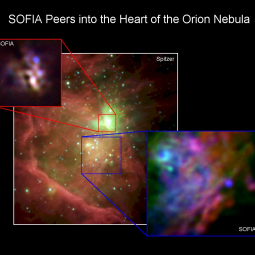Eddie Zavala, NASA SOFIA Program Manager
What an exciting time it’s been for the SOFIA Program.
As a testament to the professionalism of our aircraft maintainers and our flight, science, and instrument teams, SOFIA has departed on 93 percent of its scheduled flights, which exceeds our stated 2014 goal of 89 percent. During these operations we have achieved more than eight research hours per flight in support of more than 40 Cycle 2 guest investigators.
As of February 2014, we completed commissioning flights for four science instruments (FORCAST, GREAT, HIPO, FLITECAM) and successfully met all the requirements for our Full Operational Capability (FOC) milestone, which NASA announced on June 2. We didn't stop there. We continued to deploy new capabilities by completing commissioning flights for FIFI-LS and the GREAT instrument's new H-Channel capability, and beginning commissioning tests of the EXES instrument. At this point, all of our first-generation science instruments are operational on SOFIA.
Our work supporting NASA's goal of inspiring students to pursue science, technology, engineering, and math education paths and careers continues with SOFIA's Airborne Astronomy Ambassadors (AAA) program. This is a professional development program to improve teaching, inspire students, and inform the communities where the competitively selected ambassadors reside by giving educators the opportunity to participate in science operations first-hand on board SOFIA. To date, we have flown 55 educators from the United States and six from Germany.
On June 28, SOFIA departed from its home base at the Armstrong Flight Research Center's Palmdale, California-facility for a trans-Atlantic flight to Lufthansa Technik in Hamburg, Germany. There, engineers from the German airline will perform a decadal inspection to ensure SOFIA will operate safely for years to come. Some of our flight, aircraft maintenance, and science staffs will work along side Lufthansa's 747 specialists to perform a wide range of inspections. It is more cost-effective and will have less of an impact on our science flight schedule if this maintenance is accomplished during one extended session with Lufthansa.
While the observatory was flying science missions in late May and June, the SOFIA Science Center at NASA Ames Research Center, Moffett Field, California, released the Cycle 3 call for proposals. The Cycle 3 period will be from March 1, 2015 to Jan. 31, 2016, and offers 450 observing hours to the international scientific community. More information about the Cycle 3 call for proposals can be found on our website.
These achievements are outstanding and it is important to pause and take the time to recognize and celebrate our shared accomplishments. Moving forward we will focus our efforts to complete the aircraft and telescope maintenance visit on schedule. We will also complete work to incorporate lessons learned and ensure that all operational aspects of the program (science instruments, data pipelines, mission operations, telescope operations, etc.) are in good standing to resume science flights this fall. With the recent endorsement from the House and Senate via the FY15 budget process, I continue to be optimistic that there will be many years of continued SOFIA science!
Eddie Zavala
SOFIA Program Manager
Eddie Zavala is the program manager of the Stratospheric Observatory For Infrared Astronomy, or SOFIA, program, at NASA's Armstrong Flight Research Center, Edwards, Calif. In this position, he is responsible for overall development and operation of the SOFIA Science Center at Ames Research Center, Moffett Field, Calif., and the airborne observatory, which features a German-built 2.5-meter infrared telescope mounted in a highly modified Boeing 747SP aircraft.
The program, a cooperative effort between NASA (Armstrong and Ames research centers) and DLR, the German Aerospace Center, is the agency's next-generation airborne observatory, giving astronomers routine access to the infrared and sub-millimeter portions of the electromagnetic spectrum of the universe.
